Scientists discover a new class of extrasolar planets
Aug
31: Astronomers have announced the first discovery of a new class
of planets beyond our solar system about 10 to 20 times the size of Earth — far
smaller than any previously detected. The planets make up a class of Neptune-sized
bodies.
 FULL STORY FULL STORY
 |  |

|
 |
Smallest ever extra-solar planet discovered
Aug
29: A European team of astronomers has discovered the lightest
known planet orbiting a star other than the Sun. The new exoplanet orbits the
bright star μ (mu) Arae located in the southern constellation of the Altar.
It is the second planet discovered around this star and completes a full
revolution in 9.5 days.
 FULL STORY FULL STORY
 |  |

|
 |
South polar storms on Saturn spotted by Cassini
Aug
27: This Cassini spacecraft narrow angle camera view of Saturn's
southern polar region features a bright white spot, or storm, surrounded by
faint, darker swirls of clouds.
 FULL STORY FULL STORY
 |  |
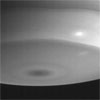
|
 |
Tiny 'David' telescope finds 'Goliath' planet
Aug
24: Fifteen years ago, the largest telescopes in the world had
yet to locate a planet orbiting another star. Today telescopes no larger
than those available in department stores are proving capable of
spotting previously unknown worlds. A newfound planet detected by
a small, 4-inch-diameter telescope demonstrates that we are at the
cusp of a new age of planet discovery.
 FULL STORY FULL STORY
 |  |

|
 |
Meteorites supplied Earth life with phosphorus
Aug
24: University of Arizona scientists have discovered that meteorites,
particularly iron meteorites, may have been critical to the evolution
of life on Earth.
 FULL STORY FULL STORY
 |  |

|
 |
Deepest image of exploded star uncovers bipolar jets
Aug
23: A spectacular new image of Cassiopeia A from NASA's Chandra
X-ray Observatory has nearly 200 times more data than the "First Light"
Chandra image of this object made five years ago. The new image
reveals clues that the initial explosion, caused by the collapse
of a massive star, was far more complicated than suspected.
 FULL STORY FULL STORY
 |  |

|
 |
Streaking away from Dione
Aug
22: Saturn's crescent moon Dione hangs before the Cassini spacecraft
in this magnified image. The icy moon shows a hint of the bright, wispy
features that mark its surface.
 FULL STORY FULL STORY
 |  |
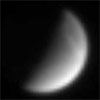
|
 |
Aug
22: Cassini
spacecraft spies Saturn's moon Iapetus
The dark material that coats one hemisphere of Saturn's moon Iapetus is very dark,
as these two processed views of the same image demonstrate.
 FULL STORY FULL STORY
 |  |
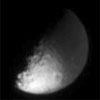
|
 |
A galaxy's fatal plunge
Aug
22: These images offer a dramatic look at C153, a galaxy being
ripped apart as it races at 4.5 million miles per hour through a distant cluster
of galaxies. The infalling galaxy's gas is being stripped by the pressure
of 20-million-degree Celsius gas that permeates the cluster.
 FULL STORY FULL STORY
 |  |

|
 |
Meteorite has record of its lunar launch site
Aug
21: Scientists have pinpointed the source of a meteorite from
the Moon for the first time. Their unique meteorite records four separate lunar
impacts.
 FULL STORY FULL STORY
 |  |

|
 |
Latest colour pictures from Cassini look like artwork
Aug
19: NASA has released three new stunning colour pictures taken
by the Cassini spacecraft exploring the planet Saturn. The images show the giant
planet, its golden rings and several moons.
 FULL STORY FULL STORY
 |  |
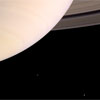
|
 |
Cooking on a comet
Aug
19: One of the ingenious instruments on board the European Space
Agency's Rosetta comet-chasing spacecraft is designed to 'smell' the comet for
different substances, analyzing samples that have been 'cooked' in a set of
miniature ovens.
 FULL STORY FULL STORY
 |  |

|
 |
Bedrock in Mars' Gusev Crater hints at watery past
Aug
18: Now that NASA's Mars Exploration Rover Spirit is finally
examining bedrock in the "Columbia Hills," it is finding evidence that water
thoroughly altered some rocks in Mars' Gusev Crater. On Opportunity, a tool
for exposing the insides of rocks stopped working Sunday, but engineers are
optimistic that the most likely diagnosis is a problem that can be fixed soon.
 FULL STORY FULL STORY
 |  |

|
 |
Out from the shadows: Two new Saturnian moons
Aug
16: With eyes sharper than any that have peered at Saturn before,
the Cassini spacecraft has uncovered two moons, which may be the smallest bodies
so far seen around the ringed planet.
 FULL STORY FULL STORY
 |  |
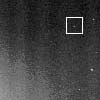
|
 |
Disk shows signs of planets
Aug
15: The sharpest image ever taken of a dust disk around another
star has revealed structures in the disk which are signs of unseen planets.
At a distance of only 33 light years, this is the nearest star possessing a
visible disk of dust, which are believed to be the birthplaces of planets.
 FULL STORY FULL STORY
 |  |

|
 |
Star clusters the leftovers from snacking galaxies
Aug
14: Globular star clusters are like spherical cathedrals of light — collections
of millions of stars lumped into a space only a few dozen light-years across.
Our own Milky Way Galaxy currently holds about 200 globular clusters, but
once possessed many more.
 FULL STORY FULL STORY
 |  |

|
 |
Chandra catches early phase of cosmic assembly
Aug
14: A NASA Chandra X-ray Observatory image has revealed a complex
of several intergalactic hot gas clouds in the process of merging. The superb
Chandra spatial resolution made it possible to distinguish individual galaxies
from the massive clouds of hot gas. One of the clouds, which envelopes hundreds
of galaxies, has an extraordinarily low concentration of iron atoms,
indicating that it is in the very early stages of cluster evolution.
 FULL STORY FULL STORY
 |  |

|
 |
Jupiter's moon Ganymede has a lumpy interior
Aug
14: Scientists have discovered irregular lumps beneath the icy
surface of Jupiter's largest moon, Ganymede. These irregular masses may be rock
formations, supported by Ganymede's icy shell for billions of years. This discovery
comes nearly a year after the orchestrated demise of NASA's Galileo spacecraft
into Jupiter's atmosphere and more than seven years after the data were collected.
 FULL STORY FULL STORY
 |  |

|
 |
Hubble peers inside a 'celestial geode'
Aug 12: In this unusual image, NASA's Hubble Space Telescope captures
a rare view of the celestial equivalent of a geode — a gas cavity carved
by the stellar wind and intense ultraviolet radiation from a hot young star.
 FULL STORY FULL STORY
 |  |

|
 |
Giant vortices found near Earth by Cluster satellites
Aug
11: ESA's quartet of space-weather watchers, Cluster, has discovered
vortices of ejected solar material high above the Earth. The superheated gases
trapped in these structures are probably tunnelling their way into the
Earth's magnetic "bubble", the magnetosphere.
 FULL STORY FULL STORY
 |  |

|
 |
Spitzer shows dying star that goes out with a ring
Aug
9: A new image from NASA's Spitzer Space Telescope shows the shimmering
embers of a dying star, and in their midst a mysterious doughnut-shaped
ring.
 FULL STORY FULL STORY
 |  |

|
 |
Dwarf irregular galaxies are not so pristine after all
Aug
8: Astronomers have shown for the first time that even the smallest
galaxies in the universe have complex structures that indicate a
complex history.
 FULL STORY FULL STORY
 |  |

|
 |
Colliding high-speed winds light up cluster
Aug
7: This Chandra image presents the first detection of X-rays from
stars in the Quintuplet Cluster, an extremely dense young star
cluster near the Galactic Centre.
 FULL STORY FULL STORY
 |  |

|
 |
Science instrument on Hubble shuts down
Aug
6: One of four science instruments aboard NASA's Hubble's Space
Telescope suspended operations earlier this week, and engineers
are now looking into possible recovery options.
 FULL STORY FULL STORY
 |  |
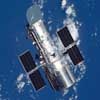
|
 |
Hubble images majestic cousin of the Milky Way
Aug
6: Our Sun and solar system are embedded in a broad pancake of stars
deep within the disk of the Milky Way galaxy. Even from a distance,
it is impossible to see our galaxy's large-scale features other
than the disk.
 FULL STORY FULL STORY
 |  |

|
 |
Newest picture from Cassini shows Saturn in colour
Aug
6: A frigid ball of gas in the blackness of space, Cassini's new home,
Saturn, appears cool and serene in this natural colour image. The
spacecraft obtained this view as it sped outward from the planet on
its initial orbit. At the left, Saturn's shadow stretches almost
completely across the rings, while at the right, the planet's
illuminated face appears to gaze down at the far-off Sun.
 FULL STORY FULL STORY
 |  |
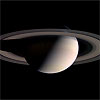
|
 |
Cassini discoveries shed light on Saturn and Titan
Aug
5: The Cassini spacecraft, which began its tour of the Saturn system
just over a month ago, has detected lightning and a new radiation
belt at Saturn, and a glow around the planet's largest moon, Titan.
 FULL STORY FULL STORY
 |  |

|
 |
Gamma-ray burst was new type of cosmic explosion
Aug
4: Astronomers have identified a new class of cosmic explosions that
are more powerful than supernovae but considerably weaker than most
gamma-ray bursts. The discovery strongly suggests a continuum between
the two previously-known classes of explosions.
 FULL STORY FULL STORY
 |  |

|
 |
South polar structure of Saturn imaged by Cassini
Aug
4: Saturn's southern polar region exhibits concentric rings of clouds
which encircle a dark spot at the pole. To the north and toward the
right, wavy patterns are evident, resulting from the atmosphere moving
with different speeds at different latitudes.
 FULL STORY FULL STORY
 |  |

|
 |
Is the solar system special?
Aug
3: On the evidence to date, our solar system could be fundamentally
different from the majority of planetary systems around stars
because it formed in a different way. If that is the case,
Earth-like planets will be very rare.
 FULL STORY FULL STORY
 |  |

|
 |



